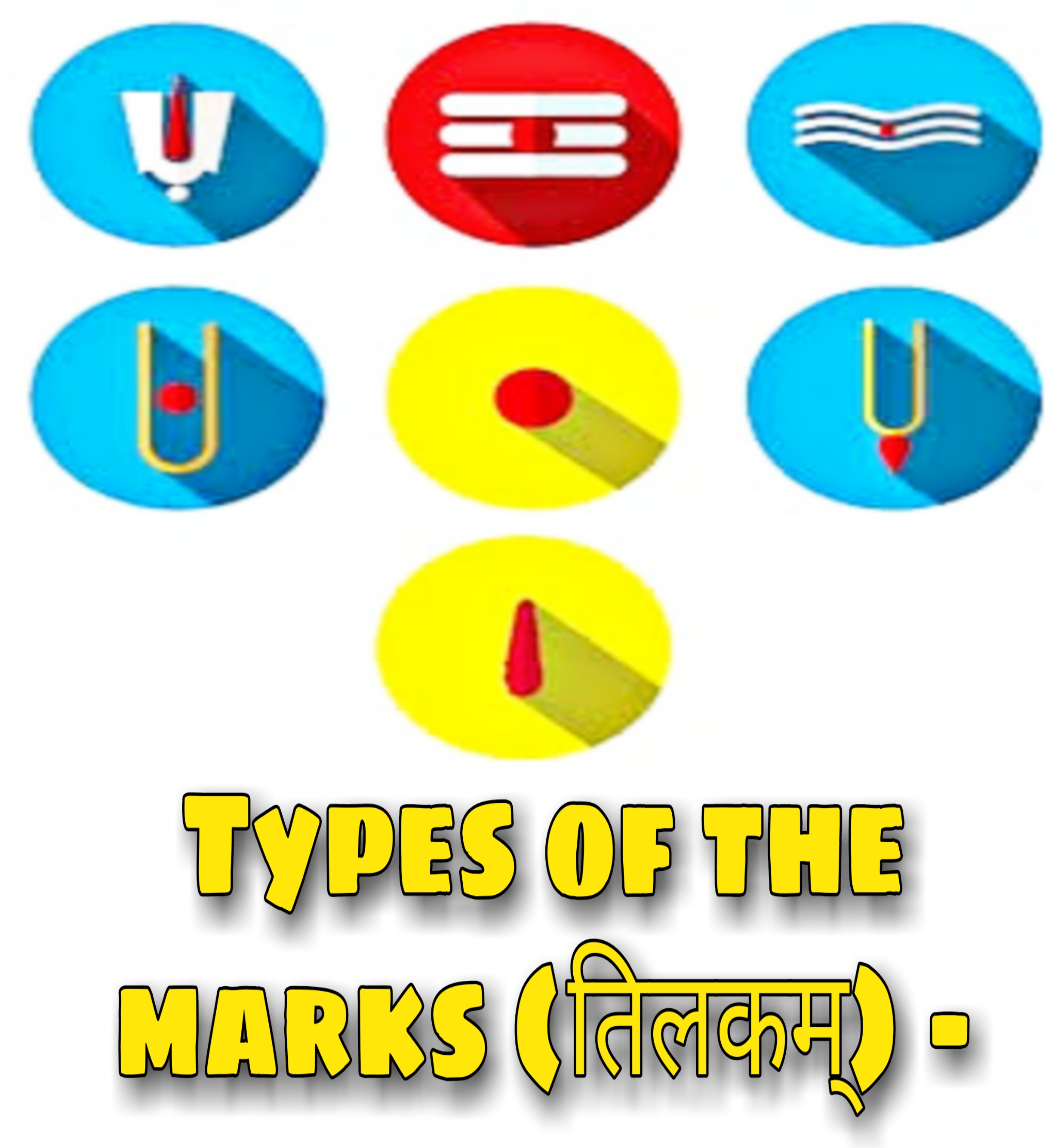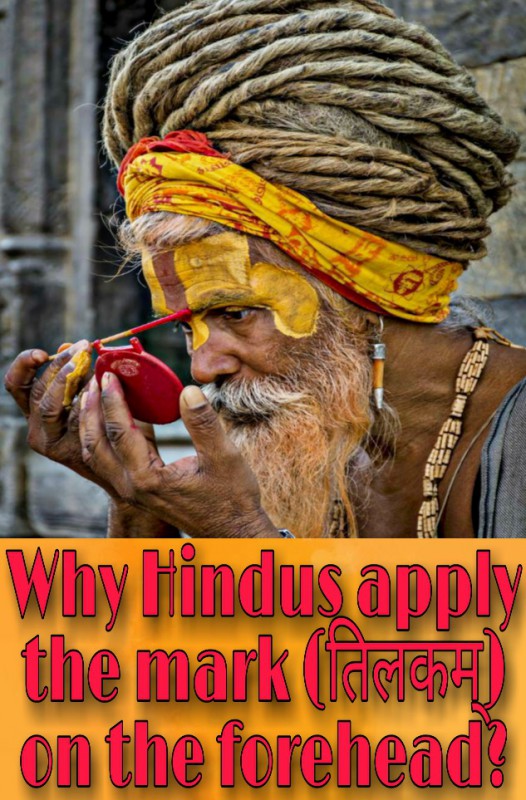In Hinduism, तिलकम् is the mark worn usually on the forehead & sometimes other parts of the body such as neck, hands, chest, etc. The mark (तिलकम्) may be worn daily or whenever one visit temple or on special religious occasions, depending on regional customs. The mark (तिलकम्) is the universal sign of Hinduism. It is the mark (तिलकम्) placed at the centre of the forehead by a priest & is regarded as a sign of devotion & blessings of the Deities. It can be a small dot or a large mark. It is a sign of good luck & is often associated with the third eye found in the middle of the forehead of few Gods & Goddesses.
For a Hindu, everything is sacred & everyone is sacred, this includes one’s own body. We consider every creation as a manifestation of the Supreme Reality (i.e. ब्रह्मन्) so, before doing any ritualistic worship, a Hindu remembers that his or her body is entirely divine. Receiving the mark (तिलकम्) is a part of mostly every ritual. The term also refers to the Hindu ritual of marking someone's forehead with a fragrant paste as a welcome & expression of honour when they arrive. There are many kinds of fragrant powders (गंधः) used in applying the mark (तिलकम्) which includes; sandalwood (चंदनम्), a powder composed of eight fragrant ingredients (अष्टगंधः), red turmeric powder (कुंकुमः), turmeric powder (हरिद्रा) & ashes of sacrificial offerings (भस्म). To Hindus, each colour is symbolic of a force of life. Red turmeric powder (कुंकुमः) is a sacred colour. Black is associated to ward off evil. Ashes of sacrificial offerings (भस्म) is linked with purity. A powder composed of eight fragrant ingredients (अष्टगंधः), of the Saffron colour is the sacred colour of Hinduism.
Scriptures state that, we should use the ring finger of the right hand to apply the mark (तिलकम्). Since this finger is associated with the heart, the vibrations flowing through it are carried to the heart.
The area in which the mark (तिलकम्) is applied is between the eyebrows is known as the Centre of the Consciousness (आज्ञा चक्रम्) & it is the 6th Centre (चक्रम्) of the body. Scientifically, this Centre of the Consciousness (आज्ञा चक्रम्) is often referred to the place of thinking, concentration & memory. It is also the area which gets heated during stress & tension. Applying the mark (तिलकम्) (generally using sandalwood) has a cooling effect & boosts concentration.
One of the most visible external symbols of Hindu identity is the mark that many of us wear on our forehead. Origin of this practice is unclear. But, in ancient times, when the caste system (वर्ण व्यवस्था) was predominated, people used to apply the mark (तिलकम्) differently that represented their caste (वर्ण). Brahmins used to apply a white sandalwood (चंदनम्) or ashes of sacrificial offerings (भस्म) signifying purity. Kshatriyas used to apply a red turmeric powder (कुंकुमः) mark (तिलकम्) signifying their valour. Vaishyas used to apply a yellow turmeric powder (हरिद्रा) mark (तिलकम्) which signifies prosperity as they were traders. Sudras used to apply a black mark (तिलकम्) representing their service to all the above three castes (वर्णs).
But later, the marks (तिलकम्) were used to denote which sect/tradition (संप्रदायः) one belongs to. The worshipers of Lord Shiva apply ashes of sacrificial offerings (भस्म) in three horizontal lines. The worshipers of Lord Vishnu apply sandalwood (चंदनम्) paste in the shape of 'U' & sometimes a vertical line in between 'U' mark. The lines & the colour may vary from region to region & from sect (संप्रदायः) to sect (संप्रदायः).

Types of the marks (तिलकम्):
There are innumerable variety of the marks (तिलकम्) Hindus wear over their forehead. And it differs by gender, sect, caste, region & much more. The mark (तिलकम्) is created by the application of powder or paste on the forehead. Different Hindu traditions use different materials & shapes to make the mark (तिलकम्).
- Shaivites, the followers of Lord Shiva, typically mark (तिलकम्) their forehead using ashes of sacrificial offerings (भस्म) in three horizontal lines across the forehead. Along with the three horizontal lines of ashes of sacrificial offerings (भस्म), a dot of red turmeric powder (कुंकुमः) in the centre completes the mark (तिलकम्). This mark is known by the names of त्रिपुण्ड्रः & Rudra-tilakam. This is traditionally done with sacred ashes (भस्म) from fire sacrifices.
- Shaktas, the worshipers of the various forms of Goddesses, mark (तिलकम्) a large vertical line or dot of red turmeric powder (कुंकुमः) on the forehead.
- Vaishnavas, the followers of Lord Vishnu, typically mark (तिलकम्) their forehead using sandalwood paste (चंदनम्) in a long vertical marking generally like the "U" shape, starting from the end of nose tip to almost below the hairline, often with an additional vertical red mark of red turmeric powder (कुंकुमः). This mark (तिलकम्) is known as ऊर्ध्व-पुण्ड्रः। This mark (तिलकम्) is traditionally made with sandalwood paste.
- The followers of Lord Ganesha, use red sandalwood paste (रक्त चन्दनम्) in a round shape mark.
- Honorary marks also known as राज-तिलकम् or विजय-तिलकम् are usually applied as a single vertical red line. राज-तिलकम् is used while enthroning kings or inviting famous personalities. विजय-तिलकम् is used to anoint victors or leaders after a war. These marks (तिलकम्) are applied with the thumb in a single upward stroke using red turmeric powder (कुंकुमः).
- The followers of Swaminarayana, mark (तिलकम्) their forehead with U-shaped in the middle of forehead using sandalwood paste (चंदनम्) along with the red dot using red turmeric powder (कुंकुमः) in the middle of U-shaped.
- The Jains, mark (तिलकम्) their forehead with a small dot of sandalwood paste (चंदनम्) mixed with some saffron (केसरम्).

Significance of the Shaivities mark (त्रिपुण्ड्रः) –
The Shiva's traditional Scriptures, explains the three horizontal lines of a त्रिपुण्ड्रः, as a reminder of various triads- three sacred fires, three syllables in ૐ, three qualities, three worlds (त्रीभुवनम्/ त्रिलोकाः), three types of Self, three powers in oneself, first three Vedas, three times of extraction of the Vedic drink Soma.
So, the explanation of the first horizontal line in (त्रिपुण्ड्रः) is, a reminder of the Sacred Fire in a household kitchen i.e. गार्हपत्याग्निः, the ‘A’ syllable of ૐ, the quality of Passion (रजस्), the Earth (भूः), the external Self, the Power of Action (क्रिया-शक्तिः) , the RigVeda, the morning extraction of Soma, & the महेश्वरः।
The second horizontal line in त्रिपुण्ड्रः is, a reminder of the Holy Fire lighted in the South for ancestors i.e. दक्षिणाग्निः, the ‘U’ syllable of ૐ, the quality of Goodness (सत्व), the Spaces (भुवः), the Inner Self, the Power of Desire (इच्छा-शक्तिः), the YajurVeda, mid-day Soma extraction & the सदाशिवः।
The third horizontal line in त्रिपुण्ड्रः is, a reminder of the Fire used for Homa i.e. आहवनियाग्निः, the ‘M’ syllable in ૐ, the quality of Ignorance (तमस्), Heaven (स्वः), the Highest Self (ब्रह्मन्), the Power of Knowledge (ज्ञान-शक्तिः), the SamaVeda, Soma extraction at dusk & the शिवः।
These three horizontal lines in त्रिपुण्ड्रः, also represents Shiva’s threefold Power- the Power of Desire (इच्छा-शक्तिः), the Power of Knowledge (ज्ञान-शक्तिः) & the Power of Action (क्रिया-शक्तिः). The त्रिपुण्ड्रः also symbolizes Shiva’s trident (त्रिशूलः) & the divine triad of Brahma, Vishnu & Shiva.

Significance of Vaishnavas mark (ऊर्ध्व-पुण्ड्रः) –
The Lord Vishnu's traditional Scriptures, similarly explains the significance of three vertical lines in ऊर्ध्व-पुण्ड्रः तिलकम् to be a reminder of Brahma, Vishnu & Shiva; the Vedic Scriptures – RigVeda, YajurVeda & SamaVeda; three worlds (त्रीभुवनम्/ त्रिलोकाः) – the Earth (भूः), Spaces (भुवः), Heaven (स्वः); the three syllables of ૐ – A, U, M; three states of Consciousness (अवस्था-त्रयम्) - Awaken (जाग्रत्), Dream sleep (स्वप्न) & Deep sleep (सुषुप्ति); three Realities – The Great Illusion (माया), The Highest Reality (ब्रह्मन्) & the Individual Soul (आत्मन्); the three bodies – Gross (स्थुलम्), Subtle (सूक्ष्मम्) & Causal (कारणम्).

Scientific reasons of applying the mark तिलकम् on forehead –
As per Sanatana Dharma, we are all energy bodies. There is constant flow of cosmic energy within the human body & also between the body & the surroundings. This energy flow in the human body happens through nerves (नाडी) which are known to total 72,000 & the nerves (नाडी) distribute life-force throughout the body. These nerves (नाडी) come together at the Centre of the Consciousness (आज्ञा चक्रम्) which is the point on the forehead above the nose & between the two eyebrows.
- Negative energy directed at this point can cause great damage & imbalance in energy flow in human body with negative consequences to the mind & body.
- Positive energy flows out from this point which we should seek to protect & we use cosmic-energy-friendly substances such as sandalwood (चंदनम्), red turmeric powder (कुंकुमः), turmeric powder (हरिद्रा), ashes of sacrificial offerings (भस्म) to cover & protect this area.
- If you want to experience reduced restlessness & increased mental peace & physical energy, try covering this area with a mark (तिलकम्) & see the difference for yourself. This is Vedic science.
- The forehead of human beings is the largest in size & only they are enabled to wisdom & empathy.
- The paste of sandalwood (चंदनम्) is known for its cooling effect & curing headaches.
- In Ayurveda, ashes of sacrificial offerings (भस्म) is said to have medicinal values, it absorbs the excess moisture & prevents one from cold & headaches.
- The mark (तिलकम्) of the red turmeric powder (कुंकुमः) is pure form of natural resources which destroys excess heat in the system, the red colour balances energy by omitting negative frequencies & helps one to get calm & relaxed state of mind.
- According to the Vedas, one must put on the mark (तिलकम्) using middle finger, by gently pressing, this allow electromagnetic waves to pass through & restore positive frequency.
- Application of the mark (तिलकम्) daily is a quick massage, be it sandalwood (चंदनम्), red turmeric powder (कुंकुमः) or ashes of sacrificial offerings (भस्म), the effect is almost the same, when they are pure in form. It permanently cures headaches, also offers instant relief from stress.
- It also cures sinus. When sinus is swollen, in turn making respiration difficult. Trigeminal nerve is stimulated by pressing this area, which increases blood pressure in the nasal passage, reduces the swelling & relieves blockage.
- Supratrochlear nerve which connects to several fibres & muscles of eyes & skin is stimulated when a mild pressure is applied on the centre of the forehead.
- Moreover, it acts as an acupressure point which is also an immune booster & potent point & when one regularly applies this mark (तिलकम्), the immunity level never comes down easily.
Thus, now we know that applying the mark (तिलकम्) on the forehead is not just a cultural or spiritual belief but one with scientific background. In Hinduism, there are many rituals & customs which we follow because it has been taught but there are reasons behind every tradition, which are important to understand. Hence, the benefits of applying the mark (तिलकम्) are numerous.
आषाढः कृष्णपक्षे १, २०७६
